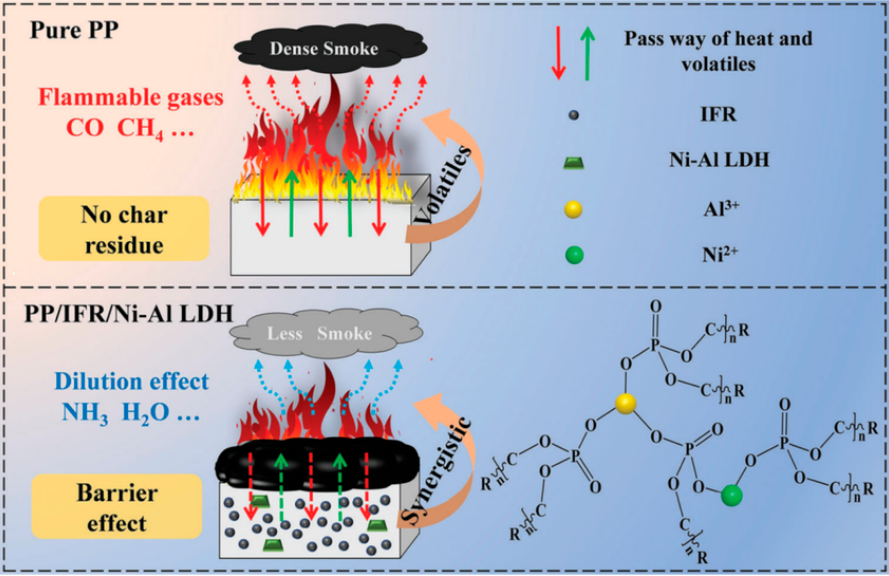Advantages of single-substance flame retardants with purity higher than 98%.
Single-substance flame retardants with a purity higher than 98% show significant advantages in many aspects compared to low-purity or composite flame retardants.
High purity ensures a highly consistent chemical composition and structure of the flame retardant, thereby improving the stability and predictability of flame retardant performance. This stability is not only reflected in the test results under laboratory conditions, but also in the reliability of the product during long-term use. Manufacturers can more reliably control product quality and ensure that flame retardant effects meet design requirements, whether in laboratory testing or actual applications.
High-purity flame retardants can usually achieve the same or better flame retardant effects at lower dosages. This not only reduces production costs and the use of raw materials, but also helps simplify the production process and improve production efficiency. Among various materials such as plastics, rubber, and coatings, the application of high-purity flame retardants is more flexible and can meet the flame retardant needs of different materials and products.
In terms of environmental protection, high-purity flame retardants usually have lower volatility and less release of harmful ingredients, helping to reduce the impact of products on the environment. High-purity flame retardants that comply with environmental standards such as ROHS and REACH can more easily pass international certification and enter the global market. This will not only help companies expand their international business, but also help enhance the competitiveness of their products in the global market.
The stability and performance advantages of high-purity flame retardants also provide companies with the basis for technological leadership. Through continuous R&D and innovation, companies can further optimize the performance of flame retardants and develop new, more efficient and environmentally friendly products to meet changing market demands and environmental protection requirements.
Single-substance flame retardants with purity higher than 98% not only have obvious advantages in flame retardant performance and application flexibility, but also lay a solid foundation for the development of enterprises in the global market by reducing costs, improving environmental performance and enhancing market competitiveness. Base.
Performance criteria when selecting single substance flame retardants for different materials.
When selecting single-substance flame retardants for different materials, several key performance criteria are crucial to ensure effective fire safety solutions. Here are the primary considerations:
Flame Retardant Efficiency: The primary function of a flame retardant is to inhibit or suppress combustion when exposed to heat or flame. The efficiency of a single-substance flame retardant is assessed by its ability to delay ignition, reduce flame spread, and minimize heat release during combustion.
Compatibility with Substrate: Single-substance flame retardants must be compatible with the specific material they are intended to protect, such as polymers (e.g., PA, PP, PBT), rubbers, textiles, or coatings. Compatibility ensures that the flame retardant does not compromise the mechanical, thermal, or aesthetic properties of the substrate.
Durability and Longevity: Flame retardants should maintain their effectiveness over the lifespan of the material or product. Factors such as exposure to environmental conditions (humidity, UV radiation) and mechanical stress should be considered to ensure long-term performance.
Thermal Stability: Single-substance flame retardants need to withstand high processing temperatures during material manufacturing without decomposition or degradation. Thermal stability ensures that the flame retardant remains effective throughout processing and during the material's use.
Toxicity and Environmental Impact: Minimizing toxicity is crucial to ensure the safety of end-users and to comply with environmental regulations. Single-substance flame retardants should be evaluated for their potential to release harmful gases or residues during combustion or recycling processes.
Regulatory Compliance: Compliance with international standards and regulations (e.g., UL 94, EN 13501, ASTM E84) is essential to confirm the flame retardant's performance and safety. Single-substance flame retardants should meet specific testing criteria and certification requirements for different applications and regions.
Processing Compatibility: The flame retardant must integrate seamlessly into the manufacturing process of the substrate material. Compatibility includes aspects such as ease of incorporation, uniform dispersion, and minimal impact on production efficiency.
Cost-Effectiveness: Balancing performance with cost considerations is critical. Single-substance flame retardants should provide effective fire protection without significantly increasing material costs or manufacturing expenses.
By considering these performance criteria, manufacturers can select the most suitable single-substance flame retardants to enhance fire safety across various materials and applications while meeting stringent regulatory and environmental standards.





 +86-0573-89103923 / +86 182 6841 1181
+86-0573-89103923 / +86 182 6841 1181


















